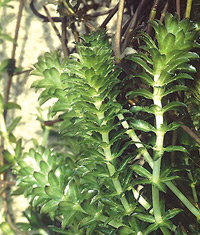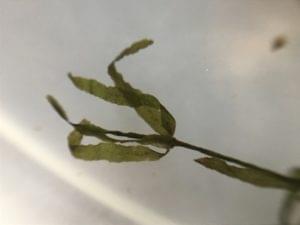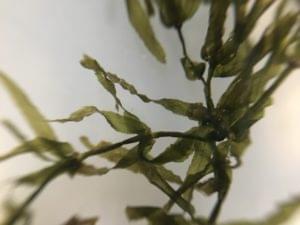Lake Champlain Steward Intercepts Hydrilla
“Clean, Drain and Dry” is the motto for boaters across the Lake Champlain basin. This was not the case for a boat and trailer that was about to be launched into Lake Champlain at the South Hero John Guilmette access site in early September. The Lake Champlain Basin Program’s boat launch steward Matthew Gorton was conducting routine courtesy boat inspections to prevent the introduction and spread of aquatic invasive species when he noticed an unusual looking plant hanging off the trailer backing up into the Lake.
Gorton was able to inspect the boat and remove the plant specimen. “We examined the plant and then brought the sample to experts from the Northeast Aquatic Plant Management Society,” said Meg Modley, Aquatic Invasive Species Management Coordinator for the Lake Champlain Basin Program (LCBP). “The specimen was then sent for genetic analysis to the University of Wisconsin-Whitewater, which confirmed the plant as hydrilla.”
While Lake Champlain is host to 51 known nonnative and invasive aquatic species, Hydrilla verticillata has not yet been found in Lake Champlain. The watercraft carrying the plant in South Hero was last in the Connecticut River, a system in which the highly invasive plant hydrilla is established.
“Research indicates that hydrilla may cause more impacts than the better-known Eurasian watermilfoil, which is already present in Lake Champlain and many lakes in the region,” said Modley. Hydrilla is an aquatic plant, common and often misnamed in aquarium trade, that grows aggressively while outcompeting most native plants. Hydrilla causes significant economic and ecological impacts in Florida where it grows in dense beds.
There are significant efforts in Cayuga Lake and the Croton River in New York to treat hydrilla infestations to prevent spread into other water bodies. A large infestation in the Connecticut portion of the Connecticut River was confirmed in 2016, and New England states have joined together to survey the Connecticut River system and address that population. Smaller infestations are present and under management in smaller bodies of water in Maine, Connecticut, and Massachusetts.
Hydrilla looks very similar to a native aquatic plant, Elodea canadensis, which is common in many New England lakes and rivers. Hydrilla is different in that it has serrated or saw-toothed edges (refer to photo of specimen taken) on the leaves and often has leaf in whorls (circles) around the stem with 4-8 leaves per whorl.
Stewards around Lake Champlain work mostly from Memorial to Labor Day weekends at launches on Lake Champlain in New York, Vermont, and Québec. The interception of this plant fragment after Labor Day suggests that there is a need for watercraft inspection and decontamination later in the season. Boat Launch Stewards encourage boaters to clear their watercraft and equipment of aquatic invasive species in an effort to protect the Lake’s ecosystem, recreation opportunities, and local economies.
The LCBP’s boat launch stewards have greeted nearly 250,000 boaters and intercepted 5,400 invasive species since the program started in 2007. The majority of these organisms have been found on boats leaving Lake Champlain, and could have been carried to other water bodies in the region if not intercepted first. The steward program is supported with funding provided by the U.S. Environmental Protection Agency (EPA) and Great Lakes Fishery Commission (GLFC) that is allocated by the Lake Champlain Steering Committee.
For more information about the steward programs or to request LCBP participation at an event, please contact lcbp@lcbp.org.
Clean-Drain-Dry!


